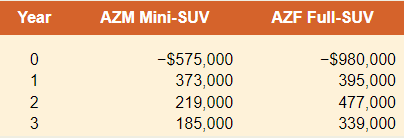
CORPORATE FINANCE- ACCESS >C<
12th Edition
ISBN: 9781307447248
Author: Ross
Publisher: MCG/CREATE
expand_more
expand_more
format_list_bulleted
Concept explainers
Textbook Question
Chapter 5, Problem 16QAP
Comparing Investment Criteria Consider the following cash flows of two mutually exclusive projects for AZ-Motorcars. Assume the discount rate for both projects is 10 percent.

a. Based on the payback period, which project should be accepted?
b. Based on the
c. Based on the
d. Based on this analysis, is incremental IRR analysis necessary? If yes, please conduct the analysis.
Expert Solution & Answer
Want to see the full answer?
Check out a sample textbook solution
Students have asked these similar questions
: A project costs $100,000 and is expected to generate cash flows of $30,000 annually for 5 years. If the discount rate is 8%, should the project be accepted based on Net Present Value (NPV)?
You are considering a project in Poland, which has an initial cost of 250,000PLN. The project is expected to return a one-time payment of 400,000PLN 5 years from now. The risk-free rate of return is 3% in Canada and 4% in Poland. The inflation rate is 2% in Canada and 5% in Poland. Currently, you can buy 375PLN for $100. How much will the payment 5 years from now be worth in dollars?
Question 6 options:
$1,576,515
$1,489,025
$101,490
$1,462,350
$142,060
: A project costs $100,000 and is expected to generate cash flows of $30,000 annually for 5 years. If the discount rate is 8%, should the project be accepted based on Net Present Value (NPV)? i need hell
Chapter 5 Solutions
CORPORATE FINANCE- ACCESS >C<
Ch. 5 - Payback Period and Net Present Value If a project...Ch. 5 - Net Present Value Suppose a project has...Ch. 5 - Comparing Investment Criteria Define each of the...Ch. 5 - Payback and Internal Rate of Return A project has...Ch. 5 - Prob. 5CQCh. 5 - Capital Budgeting Problems What are some of the...Ch. 5 - Prob. 7CQCh. 5 - Prob. 8CQCh. 5 - Net Present Value versus Profitability Index...Ch. 5 - Internal Rate of Return Projects A and B have the...
Ch. 5 - Net Present Value You are evaluating Project A and...Ch. 5 - Modified Internal Rate of Return One of the less...Ch. 5 - Net Present Value It is sometimes stated that the...Ch. 5 - Prob. 14CQCh. 5 - Prob. 1QAPCh. 5 - Prob. 2QAPCh. 5 - Prob. 3QAPCh. 5 - Prob. 4QAPCh. 5 - Prob. 5QAPCh. 5 - Prob. 6QAPCh. 5 - Prob. 7QAPCh. 5 - Prob. 8QAPCh. 5 - Prob. 9QAPCh. 5 - Prob. 10QAPCh. 5 - NPV versus IRR Consider the following cash flows...Ch. 5 - Prob. 12QAPCh. 5 - Prob. 13QAPCh. 5 - Prob. 14QAPCh. 5 - Prob. 15QAPCh. 5 - Comparing Investment Criteria Consider the...Ch. 5 - Prob. 17QAPCh. 5 - Comparing Investment Criteria Consider the...Ch. 5 - Prob. 19QAPCh. 5 - Prob. 20QAPCh. 5 - MIRR Suppose the company in the previous problem...Ch. 5 - Prob. 22QAPCh. 5 - Prob. 23QAPCh. 5 - Prob. 24QAPCh. 5 - Prob. 25QAPCh. 5 - Prob. 26QAPCh. 5 - Prob. 27QAPCh. 5 - Prob. 28QAPCh. 5 - Prob. 29QAPCh. 5 - Prob. 30QAPCh. 5 - Construct a spreadsheet to calculate the payback...Ch. 5 - Based on your analysis, should the company open...Ch. 5 - Prob. 3MC
Knowledge Booster
Learn more about
Need a deep-dive on the concept behind this application? Look no further. Learn more about this topic, finance and related others by exploring similar questions and additional content below.Similar questions
- You invest 60% of your money in Asset A (expected return = 8%, standard deviation = 12%) and 40% in Asset B (expected return = 5%, standard deviation = 8%). The correlation coefficient between the two assets is 0.3. What is the expected return and standard deviation of the portfolio? helparrow_forwardImporters and exporters are key players in the foreign exchange market. Question 10 options: True Falsearrow_forwardTriangle arbitrage helps keep the currency market in equilibrium. Question 9 options: True Falsearrow_forward
- The use of dividends is a method by which a foreign subsidiary can remit cash to its parent company. Question 8 options: True False\arrow_forwardThe notion that exchange rates adjust to keep the purchasing power of a currency constant across countries is called: Question 7 options: Interest rate parity. The unbiased forward rates condition. Uncovered interest rate parity. Purchasing power parity. The international Fisher effect.arrow_forwardThe notion that exchange rates adjust to keep the purchasing power of a currency constant across countries is called: Question 7 options: Interest rate parity. The unbiased forward rates condition. Uncovered interest rate parity. Purchasing power parity. The international Fisher effect.arrow_forward
- Suppose the direct exchange rate for the Canadian dollar and U.S. dollar is 1.11, this means that you can buy $1 U.S. for $1.11 Canadian. Question 5 options: True Falsearrow_forwardThe 60-day forward rate for Japanese Yen is x108.02 per $1. The spot rate is x103.09 per $1. In 60 days you expect to receive x1,500,000. If you agree to a forward contract, how many dollars will you receive in 60 days? Question 4 options: $154.635 million $15,312 million $13,886 million $14,550 millionarrow_forwardPlease provide correct solution with financial accounting questionarrow_forward
arrow_back_ios
SEE MORE QUESTIONS
arrow_forward_ios
Recommended textbooks for you
 Intermediate Financial Management (MindTap Course...FinanceISBN:9781337395083Author:Eugene F. Brigham, Phillip R. DavesPublisher:Cengage Learning
Intermediate Financial Management (MindTap Course...FinanceISBN:9781337395083Author:Eugene F. Brigham, Phillip R. DavesPublisher:Cengage Learning

Intermediate Financial Management (MindTap Course...
Finance
ISBN:9781337395083
Author:Eugene F. Brigham, Phillip R. Daves
Publisher:Cengage Learning

Financial Risks - Part 1; Author: KnowledgEquity - Support for CPA;https://www.youtube.com/watch?v=mFjSYlBS-VE;License: Standard youtube license